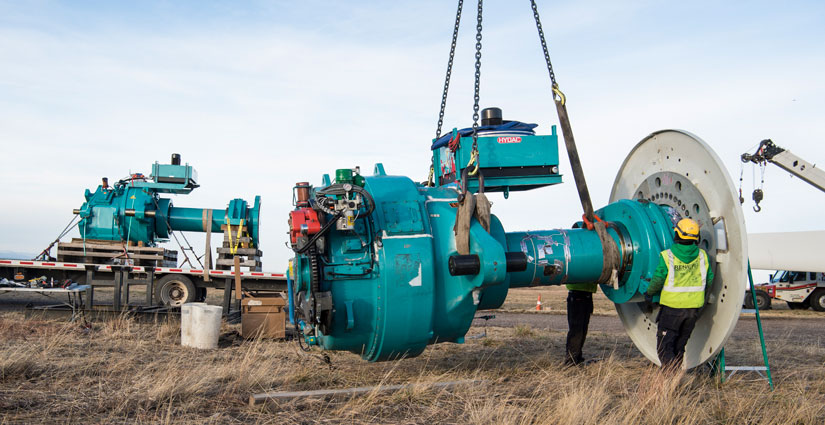Technology Innovation
NLR experts pioneered many of the capabilities that have taken wind energy to new heights.

NLR's computer modeling and experimental capabilities, as well as our deep staff expertise, are guiding wind technologies from initial concepts to deployment. We develop enhanced designs and prognostic technologies that aim to reduce operations and maintenance costs by increasing turbine reliability and plant availability. Whether investigating innovative wind turbine systems and configurations or developing new plant-level control operations, our team has a research portfolio spanning the entire technology innovation pipeline.
Capabilities
Next-Generation Technologies Innovation and Validation
Premature failures of drivetrain components—including pitch and main bearings, gearboxes, and generators—have a significant impact on the cost of wind power plant operations and maintenance. NLR develops and verifies advanced drivetrain concepts and innovative bearing, gearbox, and generator technologies.
Wind turbine blade failures are an extremely rare occurrence, but when they do happen, the results can be catastrophic. For this reason, blade manufacturers require tests of blade properties, static mechanical tests, and fatigue tests to certify wind blade and wind turbine designs. In addition to full-scale blade validation, National Wind Technology Center facilities have extensive capabilities to perform small- to large-scale subcomponent tests.
To characterize wind turbine responses to disturbances on the electric grid, NLR developed the Controllable Grid Interface (CGI) evaluation system, the first in the United States to include fault simulation capabilities, which allows manufacturers and system operators to conduct the evaluations required for certification in a controlled laboratory environment. It is the only system in the world that is fully integrated with two dynamometers and has the capacity to extend that integration to turbines in the field and to a matrix of electronic and mechanical storage devices—all of which are within close proximity.
NLR also analyzes innovative wind turbine subsystems and configurations that show promise in our ability to deploy wind energy at levels that can lead a transformation of our energy system. The lab's researchers evaluate these novel approaches through numerical modeling and simulation in advance of hardware development, reducing the risk of pursuing potentially game-changing technology.
Capabilities include:
- Aerodynamics, aeroelasticity, and structural dynamics
- Computational fluid dynamics
- Drivetrain innovation
- Drivetrain modeling, analysis, and validation
- High-performance computing
- Prognostics and health management
- Reliability, operations, and maintenance
- Systems engineering and optimization.
Energy Systems Design
NLR focuses on critical areas that reflect the long-term needs of the industry, including developing innovative controls at the turbine and plant levels, advancing modeling and simulation capabilities to assess and optimize novel designs, and supporting standards development for co-use.
Capabilities include:
- Analysis and design of innovative substructures and moorings
- Advanced modeling capabilities, validation, and optimization
- Aerodynamics, aeroelasticity, hydrodynamics, mooring systems, structural dynamics, and marine architecture
- Computational fluid dynamics.
Engineering Modeling and Validation
NLR develops and maintains open-source modeling tools for wind turbine designers, manufacturers, consultants, certifiers, researchers, and educators. Our suite of models and high-performance computing codes are capable of simulating the behavior of wind power technologies in complex environments—such as storms, earthquakes, and turbulence—and modeling the effects of turbulent inflow, unsteady aerodynamic forces, structural dynamics, drivetrain response, control systems, and hydrodynamic loading. We specialize in developing preprocessors to help build the models, postprocessors to analyze the results, and utilities to run and manage the processing tasks. NLR enables the development of advanced wind plant technologies by leveraging knowledge and data to improve physics-based engineering design competence and tools. We work collaboratively with the wind energy community to develop, validate, and apply engineering tools at the wind turbine, support structure, and plant levels.
Capabilities include:
- Physics-based engineering tools
- High- and mid-fidelity predictive simulations of complex flow physics and turbine dynamics
- Modeling turbines and plants together, multidisciplinary analyses, and overall cost of energy
- Loads analysis
- Identification of design-driving conditions.
Plant-Level Controls
NLR is researching new control methodologies, such as wake steering and consensus control, for both land-based and offshore wind plants. Advanced wind turbine controls can enable annual energy production and reduce losses by more than 20%.
Capabilities include:
- Wake control design and analysis
- Wind plant optimization
- Turbine modeling and simulation
- High-performance computing
- Data analytics and machine learning.
Projects
Resources and Tools
Annual Technology Baseline—A consistent set of technology cost and performance data for energy analysis
Composites Manufacturing Education and Technology Facility
Wind Plant Integrated System Design and Engineering Model (GitHub)
Dynamometer Research Facilities
Field and Technology Research Validation Sites
Structural Research Facilities
Explore all of NLR's wind energy facilities and data and tools.
View all wind publications.
Partner With Us
Learn more about how to work with us.
Contact
Share
Last Updated Dec. 6, 2025
